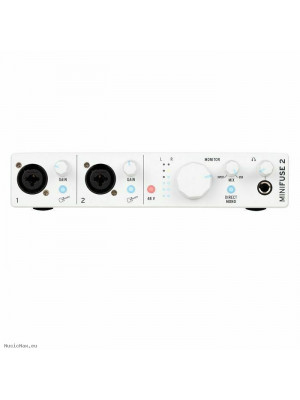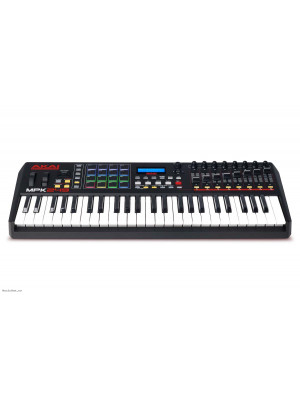Apparecchiatura da Studio
Are you interested in studio equipment?
With us you will find everything you need to be able to afford the luxury of a recording studio in the comfort of your home.
Studio equipment includes the following categories:
- Processors – ambience simulators (reverb - spring, room, plate, hall), equalizers (EQ graphic, parametric), effects (chorus, flanger, phaser, delay…), dynamic processors (compressor, limiter, expander, noise gate) …,
- Audio recorders - multi-track, with or without built-in microphones,
- Studio monitors - speakers in a housing, specially designed for professional use in music production,
- Audio interfaces - devices such as sound cards and other sound interfaces that allow one or more microphones or musical instruments to be connected for one or more recordings in the software of a personal computer,
- MIDI equipment - various controllers, keyboards, drum pads and switches that enable the transmission of MIDI protocols to which the MIDI compatible studio equipment that we want to control responds,
- Headphones and accessories
- Preamps - devices that prepare a microphone or instrument signal for processing with other studio equipment, essentially they amplify the microphone or instrument signal to the line level,
- Stands and accessories for the studio and other studio equipment used in music production.
Until the late 1970s, music could be recorded either on low-quality tape recorders or on large, expensive multi-track reel-to-reel tape recorders. Due to its high price and demanding handling, studio equipment such as multi-track reel-to-reel tape recorders was practically only available to professional studios and wealthier performers. In 1979, Tascam invented Portastudio, a small four-track recorder designed for ordinary consumers. With this new product, small multi-purpose tape recorders became available to ordinary users, and their popularity and prevalence only grew in the 1980s. In the 1990s, analog multi-track recorders were replaced by digital recorders and digital audio workstations (DAW). These new devices were designed to convert audio recordings to digital files and record these digital files to various media such as magnetic tape (e.g. ADAT), hard disk, compact disc or flash ROM.
The way the space sounds or resonates can drastically change the way you record, process, and mix music tracks. Untreated spaces have an uneven frequency response, which means that all critical processing and mixing decisions are based on sound that is already “colored,” as tonal technicians cannot hear exactly what is being played. Acoustic panels and traps for bass frequencies can improve the sound in the room.
The pandemic and related blockades in 2020 led to a dramatic increase in the number of people working from home; experts expect this to remain a constant practice in the field of sound recording even after this pandemic is over.
This brings us to the field of home recording. Home recording is the practice of recording sound in a private home instead of in a professional recording studio. A studio set up for home recording is called a home studio or project studio. Home recording is mass-produced by presenters, storytellers, singers, musicians, podcast presenters and documentary filmmakers at various levels of performance. With the advancement of technology in the 21st century, the prices of professional studio equipment are constantly declining, and information on recording techniques has become available to everyone online. These trends have led to the increasing popularity of home recording and the general shift of the recording industry to home studio recording.
Impact on professional recording studios
The rise of studio equipment accessible and suitable for home studios has severely affected professional recording studios over the past two decades. Advances in such technology, along with the very limited budgets of incoming and even established contractors, have put many commercial studios out of business. Many professional audio engineers have moved from these commercial studios to their homes to be able to offer their clients services at significantly reduced costs. The performers began to equip their home studios for self-recording and producing their own material without having to deal with high budgets and expensive studio time leases. The lack of sales of music albums in recent years and larger record labels that have cut budgets to fund their artists and producers to record in these top studios have also caused a great deal of damage. Some well-known music studios have been forced to close their doors permanently due to these circumstances. The list of these studios includes e.g. The Hit Factory and Sony Music Studios from New York and Olympic Studios and Angel Studios from London.
Although these commercial studios can create high-quality recordings for the performers who record in them, many of the recording software used in home studios can mimic what mixing consoles and multi-track tape recorders can do. The common market for computer music equipment has more than tripled in less than a decade since the turn of the millennium, and while album sales have decreased significantly over the past decade, forcing recording studios to cut costs, computer music software sales have also increased significantly. and other music-related technologies. In a way, the whole circle was closed, we went back to small business. In a similar way to how people use home recording today, the business of most professional recording studios at some point in the past began with music enthusiasts setting up a small makeshift studio to entertain or record their projects, often in the home bedroom or garage.
Risposta in Frequenza: 10Hz-30KHzDiametro: Speaker 50mmSpecificazioni: Type: ClosedSpecificazioni II: Impendance 32ohmSpecificazioni III: Sensitivity:..
25,00€ 26,32€
Prezzo più basso ultimi 30 giorni: 25,00€Risposta in Frequenza: 10Hz-38KHzDiametro: Speaker: 50mmSpecificazioni: Type: Professional closed headphonesSpecificazioni II: Impendance 32ohmSpecifi..
49,00€ 51,58€
Prezzo più basso ultimi 30 giorni: 49,00€Risposta in Frequenza: 20-20000Hz ± 0.1dBSpecificazioni: 2-in/4-out desktop USB audio interface with support for up to 32-bit/192kHz sample rate.Speci..
183,42€ 215,79€
Prezzo più basso ultimi 30 giorni: 205,00€Colore: BiancoRisposta in Frequenza: 15-20kHzDiametro: Driver Size 40mmSpecificazioni: Planar DynamicSpecificazioni II: Nominal Impedance 32ΩSpecifica..
17,00€
Prezzo più basso ultimi 30 giorni: 14,45€Colore: NeroPotenza: RMS Power: 42W (2x21W)Controlli: High Frequency Adjustments ±6dB, Low Frequency Adjustments ±6dBRisposta in Frequenza: (-10dB):55..
89,21€ 118,95€
Prezzo più basso ultimi 30 giorni: 89,21€Risposta in Frequenza: 40 - 16.000 HzSpecificazioni: Soft earshellsSpecificazioni II: Impedance: 32 OhmSpecificazioni III: Sensitivity: 105dBCaratteri..
16,00€
Prezzo più basso ultimi 30 giorni: 16,00€Risposta in Frequenza: 22 - 17,500 HzSpecificazioni: Impedance: 20 OhmSpecificazioni II: Sensitivity: 107 dB SPL/mWSpecificazioni III: RMCE remote cab..
115,00€ 121,05€
Prezzo più basso ultimi 30 giorni: 108,95€Colore: NeroRisposta in Frequenza: 20 - 19.000 HzSpecificazioni: Dual high-definition drivers deliver accurate, natural sound in a discrete, durable d..
264,10€ 278,00€
Prezzo più basso ultimi 30 giorni: 264,10€Risposta in Frequenza: 22 - 17,500 HzSpecificazioni: In-earSpecificazioni II: Dynamic MicroDriver for warm sound with dynamic bassSpecificazioni III: ..
115,00€ 121,05€
Prezzo più basso ultimi 30 giorni: 119,00€Risposta in Frequenza: 5 Hz - 30 kHzDiametro: Driver: 40 mmSpecificazioni: Impedance: 32 OhmSpecificazioni II: Sensitivity: 98 dB ± 3dBSpecificazioni ..
15,30€ 17,00€
Prezzo più basso ultimi 30 giorni: 14,45€Risposta in Frequenza: 20 Hz – 40 kHz (+-3 dB)Specificazioni: Tracks2 (stereo) 4 (stereo x2) * WAV x 2 recording mode onlySpecificazioni II: Sampling ..
253,99€ 267,36€
Prezzo più basso ultimi 30 giorni: 253,99€Colore: NeroControlli: Individually adjustable volume for each outputSpecificazioni: Input Impedance: 1000KO (unbalanced)Specificazioni II: Output Imp..
37,00€ 38,95€
Prezzo più basso ultimi 30 giorni: 37,00€Colore: BiancoSpecificazioni: Display16 characters, 2 lines (backlit LCD)Specificazioni II: Six types of high-quality vocal effects inherited from the..
238,99€ 251,57€
Prezzo più basso ultimi 30 giorni: 238,99€Specificazioni: Advanced vocal multi-effects stompbox for singing guitaristsSpecificazioni II: Automatic vocal harmony/pitch correction powered by new..
472,00€ 496,84€
Prezzo più basso ultimi 30 giorni: 472,00€Specificazioni: Number of Audio Record/Playback ChannelsRecord: 2 channelsSpecificazioni II: AD/DA conversion: 24 bitsSpecificazioni III: AD/DA conver..
229,00€ 241,05€
Prezzo più basso ultimi 30 giorni: 229,00€Specificazioni: ASIO is a trademark and software of Steinberg Media Technologies GmbH.Specificazioni II: MIC IN: -40 dBu (MicSens = Center) GUITAR IN:..
225,00€ 236,84€
Prezzo più basso ultimi 30 giorni: 213,16€Colore: NeroDiametro: 50 mm drivers deliver premium audio quality with rich, full-bodied soundSpecificazioni: Over-ear bass guitar sound system with w..
449,00€ 472,63€
Prezzo più basso ultimi 30 giorni: 449,00€Colore: BiancoControlli: Headphone level control, Monitor level controlSpecificazioni: 24 bit / 192 kHzSpecificazioni II: XLR/TRS combo input for micr..
139,65€ 147,00€
Prezzo più basso ultimi 30 giorni: 139,65€Colore: NeroSpecificazioni: Application: Acoustic PanelSpecificazioni II: Reduces acoustic distortion in listening areas to preserve clear speaker sou..
30,00€ 40,00€
Prezzo più basso ultimi 30 giorni: 30,00€Colore: NeroControlli: Monitor level controlSpecificazioni: 4x InputsSpecificazioni II: 4x OutputsSpecificazioni III: 2x HeadphonesCaratteristiche: 1x..
208,05€ 219,00€
Prezzo più basso ultimi 30 giorni: 208,05€Controlli: MPC Full Level, 16 Levels, Tap Tempo, and Time Division assist with dynamics and tempoSpecificazioni: 49 semi-weighted, full-size keys with..
409,00€ 430,53€
Prezzo più basso ultimi 30 giorni: 409,00€Specificazioni: ¼ inch (6.35mm) input jack (for guitar, bass, and also applicable for keyboards, microphones, mixers etc)Specificazioni II: 6.35mm out..
6,94€ 9,91€
Prezzo più basso ultimi 30 giorni: 6,94€Colore: BiancoControlli: Monitor level control, Headphone level controlSpecificazioni: 24 bit / 192 kHzSpecificazioni II: +48 V phantom power switchab..
96,90€ 102,00€
Prezzo più basso ultimi 30 giorni: 96,90€Potenza: Output Power: Total 45W + 45W LF 30W HF 15WControlli: Volume controlRisposta in Frequenza: 55Hz-20kHz (-3dB) 45Hz-22kHz (-10dB)Materiale: ABS..
190,00€ 200,00€
Prezzo più basso ultimi 30 giorni: 249,00€Controlli: HARMONY switch DOWN switch UP switch MENU button EXIT button PHONES/LINE knob MEMORY knob HARMONY knSpecificazioni: AD Conversion24 bits + ..
366,00€ 385,26€
Prezzo più basso ultimi 30 giorni: 366,00€Controlli: SENS 1L, 2R knobs Hi-Z switch 48V switch ,OUTPUT knob PHONES knob, POWER SOURCE switc,h DIRECT MONITSpecificazioni: Record: 2 channelsSpeci..
169,00€ 177,89€
Prezzo più basso ultimi 30 giorni: 169,00€Specificazioni: USB-bus-poweredSpecificazioni II: 1 USB Type-B PortSpecificazioni III: 64 RGB backlit clip-launch buttons in 8x8 matrixCaratteristiche..
102,00€ 107,37€
Prezzo più basso ultimi 30 giorni: 102,00€Risposta in Frequenza: 5 to 25,000 HzDiametro: 40mm neodymium driver optimized for studio recording and critical listeningSpecificazioni: Closed-back,..
152,00€ 160,00€
Prezzo più basso ultimi 30 giorni: 152,00€




























































